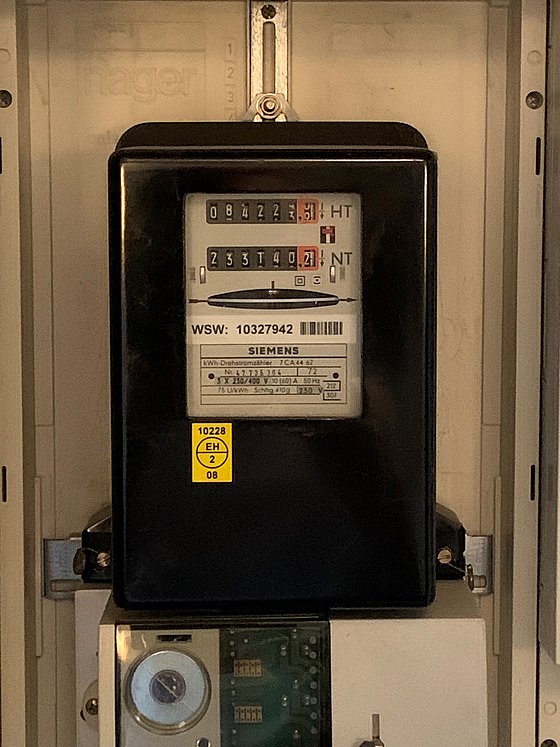
Development of a dynamic electricity tariff
Dr.-Ing. Kevin Kotthaus / Electrical power supply technology
Photo: Private
How consumers can use a flexible electricity tariff sustainably
At the Chair of Electrical Power Supply Engineering at Bergische Universität, senior engineer Dr. Kevin Kotthaus is leading the development of a dynamic electricity tariff with the Energy Markets and Flexibility Management research group.
What is the composition of the electricity of the future? Will we continue to draw fossil energy from coal, gas and oil, or will we use renewable energies from wind turbines or photovoltaics? The electricity jungle is hardly transparent for many consumers, the price fluctuations can seldom be explained to the layman, and yet knowledge of this is crucial for sustainable use. Kevin Kotthaus, senior engineer at the Chair of Electrical Power Supply Technology at Bergische Universität, is working on the development of a dynamic electricity tariff that users should be able to track at any time in order to retrieve their consumption accordingly in a sustainable manner.
The long road to a flexible electricity tariff
'Autoflex` is the shorthand description of a project at the Chair of Electrical Power Supply Technology that deals with the automated and standardized integration of flexibility options for private and commercial consumers. "The idea is to develop a dynamic electricity tariff," explains Kotthaus, "that works in such a way that the electricity price fluctuations you see on the wholesale market also reach the end customer, who can then practically react to them." So when the price of electricity is low, energy consumption naturally has an economic advantage in that time window, he says. The biggest challenge here, he says, is to develop a well-functioning system that offers the technical prerequisites to enable consumers to track electricity price fluctuations at any time. Kotthaus is talking about standardizing the systems. For example, so-called smart home systems could be used in the future. Through these, home or apartment owners can regulate their electricity consumption at any time, if associated controllable processes were compatible with each other. "So you have to develop a certain technical standard, harmonize the interfaces, so that the whole thing can also be implemented without hurdles for the end consumer."

Consumers would like to see a dynamic electricity tariff
(Photo: UniService Transfer)
A dynamic electricity tariff
For years, motorists have been familiar with the perceived hourly price changes at gas stations. Similarly, dynamic electricity tariffs are passed on to consumers. The requirement for standardization here, he said, lies in the best possible timeliness and transparency of the system. "If they have a classic tariff" says Kotthaus, "then it is first certain, the kilowatt hour as a labor price costs sum X. The tariff is then standardized. With the dynamic electricity tariff, we are more up-to-date. The price can change practically from one day to the next. In order for the customer to understand this, however, i.e. to be able to track price increases and decreases, the system must also be designed to be transparent. "The current presentation of the individual components of an electricity price is often only communicated to the end customer in a very non-transparent way, making the whole thing a bit customer-unfriendly," says the scientist, explaining the situation. "A flexible electricity tariff, on the other hand, must be able to explain compellingly to the user when he must also pay which components of this electricity cost and how."
Avoid critical grid situations - use electricity effectively
The layperson likes to associate critical grid situations with disaster scenarios such as a blackout. But it can also happen regionally or locally on one's own doorstep that the low-voltage grid cannot maintain the right voltage due to overload. Kotthaus gives an example: "The thermal overload of equipment limits: Ten single-family homes suddenly have ten charging stations, all with 22 kW, which is a relatively high power for the low-voltage grid. And they all turn on at the same time. The cable in the street then simply cannot thermally tolerate this sum at the same time. In the worst case, the cable practically burns out and outages occur." At this point, a dynamic system would also require the flexibility of the customer, who could also adjust his energy consumption to suit the grid in such cases. In his project, Kotthaus is looking at power-intensive electricity processes such as cooling applications or heating applications in small businesses or stationary energy storage systems in private households to find flexible consumption options for effectively using the available electricity.
Integrating renewables better
"The current situation in Germany is such that at times we can already cover our loads with 100% renewable electricity," Kotthaus says. But the question that arises is: how regionally available are renewables? That's not the same across the board, he says, but depends regionally and locally on how many renewable energy generation plants you have on the grid. "The project helps to better integrate these plants, to dynamically adapt consumption behavior to them, and then to primarily use electricity when a lot of renewable electricity is available."
Consumer education
An important prerequisite for the use of a flexible electricity tariff is, above all, customer acceptance, he said. Therefore, a survey has already been carried out in the course of the project to record customer wishes and integrate them if necessary. "A flexible electricity customer must somehow be encouraged to behave flexibly," explains the expert, and financial relief plays a key role here. Many answers also refer to a reduction of one's own CO₂ footprint in the course of the energy transition, so that every survey also always means a kind of consumer information and education that generates acceptance in the long term. The fact is, "everything has to become simpler," Kotthaus continues. Using the example of photovoltaic systems on the roof of one's own house, he says, users can easily understand how to implement optimal electricity consumption. "It's best for me to consume the self-generated energy through the photovoltaic system on the roof myself first, because that's where it's worth the most to me. Everything you can consume yourself, you should consume, adjusted to the generation of these plants, maybe even controlled via a smart-home system." Basically, he says, user behavior needs to change so that people shift their consumption to peak generation times, the times when there really is a lot of renewable electricity, to stabilize the overall system."
Wuppertal energy weather clock
A new Wuppertal user tool that continuously shows consumers when a high amount of renewable energy is available has been released by Wuppertal's municipal utilities in parallel with the Autoflex project. The Energy Weather Clock. "This is a clock that shows at what hour and at what time the highest possible share of renewable energy is available in the current regional or local grid," Kotthaus explains. "You can see everything from the red light to the green light. The green light at two o'clock, for example, means now there's enough renewable power to use. You can put this clock on the kitchen cabinet with a connection to the Internet, so you can read the cheapest time to use electricity."
More energy needed in the future
"We will certainly consume more electrical energy in the future. Many processes, especially heating processes, which are now still based on fossil combustion, are to be electrified," predicts Kotthaus. On the road to sustainability, green electricity is indispensable. "The future added value will be that consumption behavior will be oriented to the times when there is really a lot of green power in the grid, which would otherwise also be lost." You have to take advantage of the generation peaks, because if consumption is too low during those times, the engineer explains, consumption will be capped, which means wind turbines will stand still and photovoltaic systems will be shut down because the grid can't absorb the energy. "When there is a lot of renewable power, the wholesale price is also low. This understanding needs to solidify with customers. Then it will also quickly become clear that the actual cost to the customer will be lower."
In order to convert the existing system, one repeatedly comes up against the limits of what is feasible, Kotthaus sums up, a lack of skilled workers in the heat transition as well as material bottlenecks are major problems, but the acceptance among the population is increasing enormously. "The experiences that are being made are consistently positive."
Uwe Blass
Dr.-Ing. Kevin Kotthaus is a senior engineer at the Chair of Electrical Power Supply Engineering in the Faculty of Electrical Engineering, Information Technology and Media Technology at Bergische Universität.
